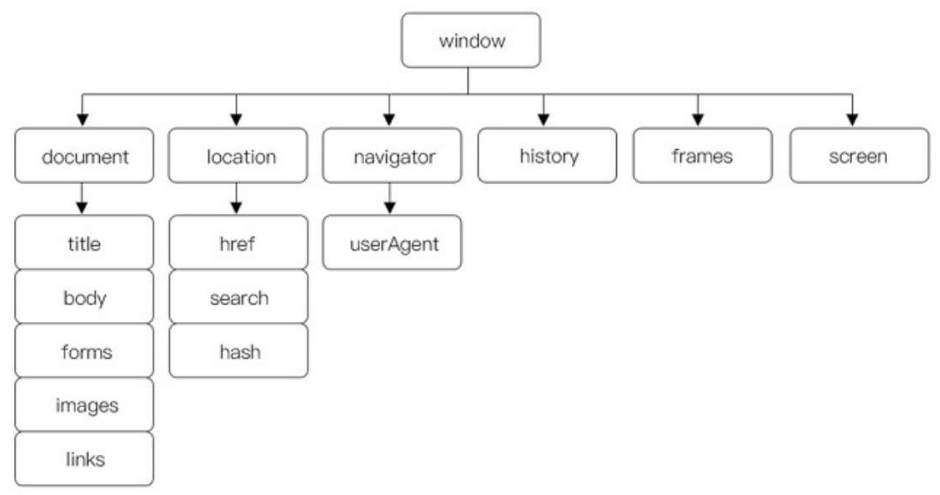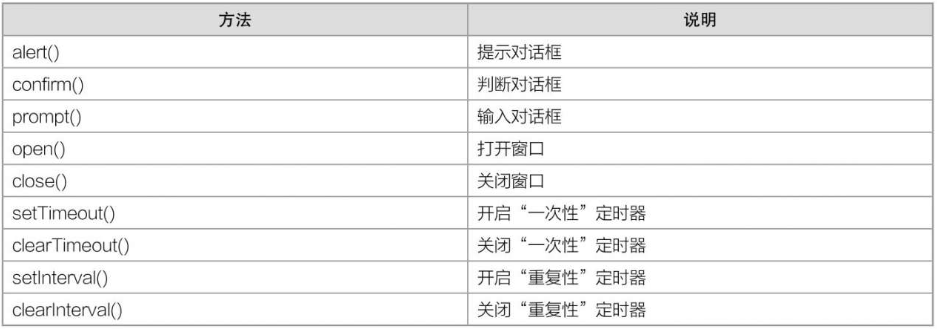简介
在 JavaScript 中,一个浏览器窗口就是一个 window 对象,简单地说,JavaScript 会把一个窗口看成一个对象,这样我们就可以用这个对象的属性和方法来操作这个窗口。实际上,我们在打开一个页面时,浏览器都会自动为这个页面创建一个 window 对象。
window 对象存放了这个页面的所有信息,为了更好地分类处理这些信息,window 对象下面又分为很多对象。
 window 对象及下面这些 location、navigator 等子对象,由于都是用于操作浏览器窗口的,所以我们又称之为“BOM”,也就是 Browser Object Module(浏览器对象模型)。
window 对象及下面这些 location、navigator 等子对象,由于都是用于操作浏览器窗口的,所以我们又称之为“BOM”,也就是 Browser Object Module(浏览器对象模型)。
窗口操作
打开窗口
window.open(url,target)
url 指的是新窗口的地址,如果 url 为空,则表示打开一个空白窗口。空白窗口很有用,我们可以使用 document.write( )往空白窗口输出文本,甚至输出一个 HTML 页面。
target 表示打开方式,它的取值跟 a 标签中 target 属性的取值是一样的,常用取值有两个:_blank 和 _self。当 target 为“_blank(默认值)”时,表示在新窗口中打开;当 target 为“_self”时,表示在当前窗口中打开。
oBtn.onclick = function(){window.open("https://www.yuque.com/explore/events");window.open("https://www.yuque.com/explore/events","_blank");}
<!DOCTYPE html><html lang="en"><head><meta charset="UTF-8"><meta http-equiv="X-UA-Compatible" content="IE=edge"><meta name="viewport" content="width=device-width, initial-scale=1.0"><title>Document</title><script>window.onload = function(){var oBtn = document.getElementById("btn");oBtn.onclick = function(){var opener = window.open();opener.document.write("a new page")opener.document.body.style.backgroundColor = "blue";}}</script></head><body><input type="button" id="btn" value="button"></body></html>
window.open( )就像函数调用一样,会返回(也就是 return)一个值,这个值就是新窗口对应的 window 对象。
如果打开的是同一个域名下的页面或空白窗口,就可以像上面那样操作新窗口的元素或样式;但是如果打开的是另外一个域名下的页面,是不允许操作新窗口的内容的,因为涉及跨域的问题。
<!DOCTYPE html>
<html lang="en">
<head>
<meta charset="UTF-8">
<meta http-equiv="X-UA-Compatible" content="IE=edge">
<meta name="viewport" content="width=device-width, initial-scale=1.0">
<title>Document</title>
<script>
window.onload = function(){
var oBtn = document.getElementById("btn");
var opener = null;
oBtn.onclick = function(){
opener = window.open();
var strHtml = '<!DOCTYPE html>\
<html lang="en">\
<head>\
<title>Document</title>\
</head>\
<body>\
<strong>someting</strong>\
</body>\
</html>';
opener.document.write(strHtml);
}
}
</script>
</head>
<body>
<input type="button" id="btn" value="button">
</body>
</html>
关闭窗口
window.close()
对话框
alert
这个方法在之前用了很多次,这里不再多说。对于 alert( ),只需记住一点:在 alert( )中实现文本换行,用的是 \n。
confirm( )
提供文字,提供确认。
confirm("提示文字")
如果用户点击【确定】按钮,confirm( )会返回 true;如果用户点击【取消】按钮,则会返回 false。
<!DOCTYPE html>
<html lang="en">
<head>
<meta charset="UTF-8">
<meta http-equiv="X-UA-Compatible" content="IE=edge">
<meta name="viewport" content="width=device-width, initial-scale=1.0">
<title>Document</title>
<script>
window.onload = function () {
var oBtn = document.getElementById("btn");
oBtn.onclick = function () {
if(confirm("are you sure?")){
window.location.href = "https://weread.qq.com/web/reader/1fb32f0071cad7841fb22d7k65b326f026965b9eea6e6e1";
}
}
}
</script>
</head>
<body>
<input type="button" id="btn">
</body>
</html>
prompt
prompt( )对话框不仅会提示文字,还会返回一个字符串。
prompt("提示文字")
<!DOCTYPE html>
<html lang="en">
<head>
<meta charset="UTF-8">
<meta http-equiv="X-UA-Compatible" content="IE=edge">
<meta name="viewport" content="width=device-width, initial-scale=1.0">
<title>Document</title>
<script>
window.onload = function () {
var oBtn = document.getElementById("btn");
oBtn.onclick = function () {
var name = prompt("enter your name");
document.write("welcome "+name);
}
}
</script>
</head>
<body>
<input type="button" id="btn">
</body>
</html>

一般不会采用默认的对话框,之后会进行学习。
定时器
实现网页计时,轮播图等,每隔一段事件就执行一次代码。
setTimeout( )和 clearTimeout( )
在 JavaScript 中,我们可以使用 setTimeout( )方法来“一次性”地调用函数,并且可以使用 clearTimeout( )来取消执行 setTimeout( )。
setTimeout(code,time)
参数 code 可以是一段代码,可以是一个函数,也可以是一个函数名。参数 time 是时间,单位为毫秒,表示要过多长时间才执行 code 中的代码。
<script>
window.onload = function () {
setTimeout('alert("欢迎")',2000)
}
</script>
<script>
window.onload = function () {
setTimeout(function(){alert("欢迎")},2000)
}
</script>
<script>
window.onload = function () {
//两种方式等价
setTimeout(alertMes,2000)
setTimeout("alertMes()",2000)
}
function alertMes(){
alert("欢迎");
}
</script>
<!DOCTYPE html>
<html lang="en">
<head>
<meta charset="UTF-8">
<meta http-equiv="X-UA-Compatible" content="IE=edge">
<meta name="viewport" content="width=device-width, initial-scale=1.0">
<title>Document</title>
<script>
window.onload = function () {
var oBtn = document.getElementsByTagName("input");
var timer = null;
oBtn[0].onclick = function () {
timer = setTimeout(
function () { alert("welcome") }, 2000
)
}
oBtn[1].onclick = function () {
clearTimeout(timer)
}
}
</script>
</head>
<body>
<p>点击按钮,两秒后提示欢迎语句</p>
<input type="button" value="开始">
<input type="button" value="暂停">
</body>
</html>
如果点击【开始】按钮,2秒后就会弹出对话框。如果在 2 秒内再次点击【暂停】按钮,就不会弹出对话框。
setInterval( )和 clearInterval( )
在 JavaScript 中,我们可以使用 setInterval( )方法来“重复性”地调用函数,并且可以使用 clearInterval( )来取消执行 setInterval( )。
setInterval(code,time);
三种写法,同上。
<!DOCTYPE html>
<html lang="en">
<head>
<meta charset="UTF-8">
<meta http-equiv="X-UA-Compatible" content="IE=edge">
<meta name="viewport" content="width=device-width, initial-scale=1.0">
<title>Document</title>
<script>
window.onload = function () {
var n = 5;
setInterval(countDown,1000);
function countDown(){
if(n > 0){
n--;
document.getElementById("num").innerHTML = n;
}
}
}
</script>
</head>
<body>
<div>倒计时:<span id="num">5</span></div>
</body>
</html>
<!DOCTYPE html>
<html lang="en">
<head>
<meta charset="UTF-8">
<meta http-equiv="X-UA-Compatible" content="IE=edge">
<meta name="viewport" content="width=device-width, initial-scale=1.0">
<title>Document</title>
<style type="text/css">
div{width: 100px;height: 100px;border: 1px solid silver;}
</style>
<script>
window.onload = function(){
var oBtn = document.getElementsByTagName("input");
var oDiv = document.getElementsByTagName("div")[0];
var colors = ["red","blue","orange","yellow","green","blue","purple"];
var timer = null;
var i = 0;
oBtn[0].onclick = function(){
timer = setInterval(
function(){oDiv.style.backgroundColor = colors[i];i++;i%=colors.length},1000
)
oBtn[1].onclick = function(){
clearInterval(timer);
}
}
}
</script>
</head>
<body>
<input type="button" value="开始">
<input type="button" value="暂停">
<div></div>
</body>
</html>
其实每点击一次,都会新开一个 setInterval( ),如果你不断点击按钮, setInterval( )就会累加起来。也就是说,当你点击 3 次按钮时,其实已经开了 3 个 setInterval( ),此时如果想要停下来,就必须点击 3 次【暂停】按钮。为了避免产生这个累加的 bug,我们在每次点击【开始】按钮时就要清除一次定时器,改进后的代码如下。
<!DOCTYPE html>
<html lang="en">
<head>
<meta charset="UTF-8">
<meta http-equiv="X-UA-Compatible" content="IE=edge">
<meta name="viewport" content="width=device-width, initial-scale=1.0">
<title>Document</title>
<style type="text/css">
div{width: 100px;height: 100px;border: 1px solid silver;}
</style>
<script>
window.onload = function(){
var oBtn = document.getElementsByTagName("input");
var oDiv = document.getElementsByTagName("div")[0];
var colors = ["red","blue","orange","yellow","green","blue","purple"];
var timer = null;
var i = 0;
oBtn[0].onclick = function(){
clearInterval(timer);
timer = setInterval(
function(){oDiv.style.backgroundColor = colors[i];i++;i%=colors.length},1000
)
oBtn[1].onclick = function(){
clearInterval(timer);
}
}
}
</script>
</head>
<body>
<input type="button" value="开始">
<input type="button" value="暂停">
<div></div>
</body>
</html>
优化:每一次点击开始之后就清除一次计时器。
location 对象
在 JavaScript 中,我们可以使用 window 对象下的 location 子对象来操作当前窗口的 URL。所谓的 URL,指的就是页面地址。对于 location 对象,我们只需要掌握以下 3 个属性:
window.location.href
<script>
var url = window.location.href;
document.write("URL: "+url);
</script>
<!DOCTYPE html>
<html lang="en">
<head>
<meta charset="UTF-8">
<meta http-equiv="X-UA-Compatible" content="IE=edge">
<meta name="viewport" content="width=device-width, initial-scale=1.0">
<title>Document</title>
<script>
setTimeout(function(){
window.location.href = "https://www.bilibili.com/";
},2000);
</script>
</head>
<body>
<p>两秒后跳转</p>
</body>
</html>
window.location.search
我们可以使用 location 对象的 search 属性来获取和设置当前页面地址“?”后面的内容。
<script>
document.write(window.location.search);
</script>
此时页面是空白的,我们在浏览器地址后面加上 ?id=1(要自己手动输入),再刷新页面,就会出现结果了。
window.location.hash
我们可以使用 location 对象的 hash 属性来获取和设置当前页面地址井号(#)后面的内容。
<script>
document.write(window.location.hash);
</script>
navigator 对象
我们可以使用 window 对象下的子对象 navigator 来获取浏览器的类型。
<script>
document.write(window.navigator.userAgent);
</script>

